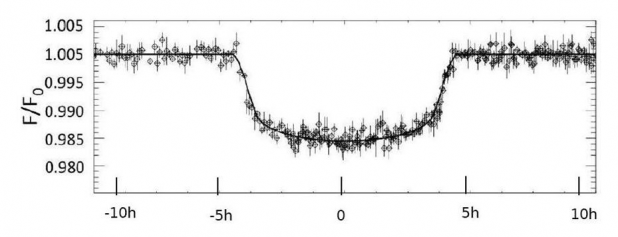An international team, combining 145 days of measurements from the satellite CoRoT of CNES with data from the HARPS spectrograph of ESO, discovered a new exoplanet –baptized CoRoT-9 b– in the Snake constellation, some 1500 light years away from Earth.

A transiting planet
Of the 430 exoplanets discovered to this day –of which 8 were discovered by CoRoT and published recently–, only around 70 of them are transiting planets. Transiting planets are scientifically interesting as they enable spectroscopic measurements of the planet’s atmosphere to detect specific molecular lines. It is thus possible to know which molecules are present in the atmosphere and in what quantities. Tristan Guillot, astrophysicist in the Cassiopée laboratory (OCA) says “following the planetary evolution models which resemble those for the giant planets of our Solar System, CoRoT-9 b is mainly made up of hydrogen and helium but could contain up to 20 terrestrial masses worth of other elements, such as water and rocks at high temperature and pressure."
A temperate exoJupiter
Until now, all the known transiting exoplanets were so close to their star at some point of their orbit that their temperature reached 1300°C, hence the name ‘hot Jupiter’. CoRoT-9 b’s radius is 1.05 that of Jupiter and its mass 0.8 time Jupiter’s. But what makes this planet remarkable is that it orbits its star 10 times further than known hot Jupiters1.
CoRoT-9 b’s orbital period is of 95 days on a slightly elliptic orbit. It must hence be approximately 0.4AU away from its star, which is roughly the distance Sun-Mercury. The planet is heated by its star, and since the latter is slightly less luminous than the Sun, CoRoT-9 b must be slightly colder than Mercury. Its exact temperature depends on its ability to absorb the light emissions from its star. Due to its slightly elliptic orbit (0.1), the temperature must vary, depending on the efficiency of its greenhouse effect, between -20 and 160°C. “CoRoT-9 b would thus be the coldest giant planet detected by transit to this day” adds Claire Moutou from LAM. If this planet possessed a satellite such as Titan or Encelade and if the temperature variations were limited to 0 – 50°C, this satellite could eventually host liquid water. Moreover, being permanently quite far from its star, it is not affected by tidal effects. As a consequence, there is no internal heat source which facilitates modelling.
1 The total period of observation by CoRoT for this star was 145 days. With an orbital period of 95 days for CoRoT-9 b, the satellite only could observe 2 transits of the planet in front of its host star.
Comparative exo-planetology
CoRoT-9 b paves the way for the study of a new panel of intermediate temperatures between those of hot Jupiters around 1000°C and those of our own Jupiter around -100°C. A few dozen temperate Jupiters are already known but this one is the first known transiting one. Future spectroscopic analyses will thus enter unknown territory. “Chemical equilibriums” of the atmosphere could be observed, for example the abundance of carbon dioxide compared to methane and the way these equilibriums change depending on the temperature of the exoplanet in question. Stable molecules at CoRoT-9 b’s temperature but unstable at hot Jupiters’ temperatures could also be detected.
After a period of statistical analysis of observations, the era of comparative exo-planetology seems well under way and is guaranteed to bring fascinating discoveries. This will be made possible by ground observations from the Sphere camera on the VLT in Chile on the future ELT on the European side, but also by Gaia and by the JWST in space.
Article references
Contacts
- Scientific contact: Claire Moutou, Laboratoire d'Astrophysique de Marseille (LAM) 38 rue Frédéric Joliot-Curie 13388 MARSEILLE CEDEX (France)
- Astrophysics program scientist: Olivier La Marle